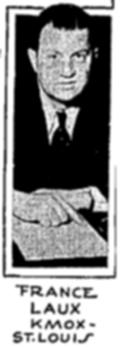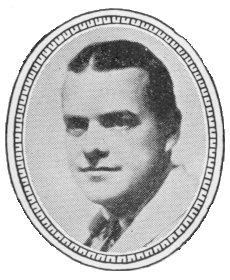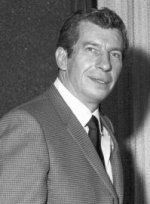Radio Articles
Laux Got To The Top Quickly
Sportscaster France Laux liked to tell people he began in the business at the top. When he died, 51 years after his incongruous start in broadcasting, it was mainly the old timers who mourned.

His first appearance behind a radio microphone was as the broadcaster of the opening game of the 1927 World Series. He wasn’t at the ball park. Rather, like many of his radio contemporaries, he got all of his information from the Western Union ticker and described the game to his listeners from the studios of station KVOO in Tulsa.
Laux had been hired for the job 50 minutes before the game began, to replace KVOO’s regular announcer who was sick, but his hiring was even more unorthodox than it may seem at first glance. The KVOO manager tried to contact him at his home in Bristow, Ok. He was told Laux was somewhere in the town’s business district. The manager drove to Bristow, found him and raced back to the KVOO studios, 45 minutes away. The two men arrived at the radio station 90 seconds before airtime. For his new full-time job Laux was paid $30 per week.
Two years later he was called to come to KMOX in St. Louis for a tryout, based on a letter he’d written. Laux once told a reporter, “I was listening to a wrestling match at about 2 o’clock one morning and I decided to write to KMOX to see if they had any openings.” In moving to KMOX, Laux paved the way to become on of the nation’s best-known baseball broadcasters.
In those days, St. Louis radio stations only aired home games, but since both the Cardinals and Browns played at Sportsman’s Park, there was usually a broadcast every day. Once, in 1934, the Cards were in the pennant race, so the station sent Laux on the road to air a double header from Wrigley Field, and he supplemented the broadcast with two more games – a double header featuring the Browns – using Western Union’s ticker.
Not all of Laux’s work was with KMOX. As is the case today, he had to follow the clubs to whichever stations were carrying the games, so his voice was also heard on WEW, WTMV and KXOK. In addition, he was called upon to handle play-by-play duties in nine World Series and nine All-Star Games and was given the first Radio Announcer of the Year award by The Sporting News in 1937. And not all of his work involved baseball. He did play-by-play of basketball, wrestling, boxing, St. Louis Flyers’ hockey and Missouri, Illinois and Notre Dame football.
In 1938, The Sporting News noted that Laux had begun broadcasting an early morning sports review for the smaller communities surrounding St. Louis, which was recorded the night before and aired in the early morning farm program block. The show included information on minor league, semi-professional and local teams.
Combine a heavy broadcast schedule with the many calls that came into the station for personal appearances and it’s easy to see why France Laux was considered the voice of sports in St. Louis. The reasoning behind his removal from baseball broadcasts is lost in time, but he was replaced in 1946.
There were new voices to be heard, like a youngster named Harry Caray, along with Dizzy Dean, Gabby Street and Johnny O’Hara. It was a difficult transition for Laux. Baseball had been his love and the path to his national success. He stayed on radio awhile, doing other sports programs, but his air time dwindled and he was seldom heard after 1953. At that point, Laux embraced his second love: bowling. He bought a bowling alley and attacked things with the same passion he had shown years before as a young broadcaster, rising to the appointed position of secretary of the National Bowling Congress.
The late Bob Broeg once said Laux’s early background ended up working against him. As a low-key, quiet person, Laux concentrated on unbiased reporting of the game. But when the new guys showed up, Broeg remembered to author Curt Smith, “…when he had to entertain – to be flashy like his competitors, the Deans and Harry Carays – he couldn’t do it. People said that he was too old-timey.”
The late Jack Buck told Smith that most people simply forgot about Laux since there were flashy guys who took his place. In Buck’s words, “He went out pretty shabbily.”
In the end Laux was philosophical about his professional demise: “I just lived too long,” he lamented.
(Reprinted with permission of the St. Louis Journalism Review. Originally published 8/2009)

